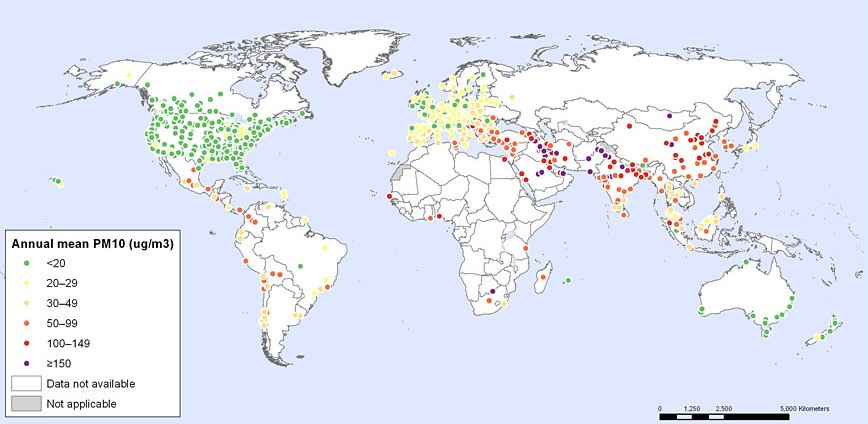WHO warns on urban air pollution
28 September 2011
Air pollution in many cities around the world is increasingly reaching levels that threaten people's health, according to a study by the World Health Organization (WHO). Motor vehicles and fossil fuel power plants are among the major contributors, it said.
According to WHO, more than two million people die per year from breathing in tiny particles present in indoor and outdoor air pollution. Particles of 10 micrometers or less -'PM10' particles - which can penetrate into the lungs and may enter the bloodstream, can cause heart disease, lung cancer, asthma, and acute lower respiratory infections.
 |
| Exposure to PM10 in 1081 cities, 2003-2010. Click to enlarge (Image: WHO) |
WHO has studied publicly-available air quality data from almost 1100 cities across 91 countries, including capital cities and cities with populations of more than 100,000 people. The data used are based on measurements taken from 2003 to 2010, with most being reported for the period 2008-2009.
The WHO air quality guidelines for PM10 is 20 micrograms per cubic metre (μg/m3) as an annual average. However, its study found that the average PM10 in some cities is more than ten times this amount.
The highest average annual PM10 level was found in the Iranian city of Ahwaz, with a reading of 372 μg/m3, followed by Ulaanbaatar in Mongolia at 279 μg/m3. Eleven cities were found to have annual levels above 200 μg/m3. The majority of the cities recording levels below 20 μg/m3 are in the USA and Canada.
"Persistently elevated levels of fine particle pollution are common across many urban areas," the organization said. "On average, only a few cities currently meet the WHO guideline values." The data showed that 591 of the 1081 cities studied have average PM10 levels above 20 μg/m3.
The study concludes that the estimated mortality in 2008 attributable to outdoor air pollution in cities was 1.34 million premature deaths. WHO claims that, if its guidelines had been universally met, some 1.09 million deaths could have been prevented in 2008. The number of deaths attributable to air pollution in cities has increased from the previous estimate of 1.15 million deaths in 2004. This increase is attributed to increases in air pollution concentrations and in urban population sizes, as well as improved data availability and methods employed.
WHO said the largest contributors to urban outdoor air pollution - both in developed and developing countries - include motor transport, small-scale manufacturers and other industries, burning of biomass and coal for cooking and heating, as well as coal-fired power plants. Residential wood and coal burning for space heating is an important contributor to air pollution, especially in rural areas during colder months.
Maria Neira, WHO director for public health and environment, said: "Air pollution is a major environmental health issue and it is vital that we increase efforts to reduce the health burden it creates. If we monitor and manage the environment properly we can significantly reduce the number of people suffering from respiratory and heart disease, and lung cancer."
She added, "Across the world, city air is often thick with exhaust fumes, factory smoke or soot from coal burning power plants. In many countries there are no air quality regulations and, where they do exist, national standards and their enforcement vary markedly."
Researched and written
by World Nuclear News